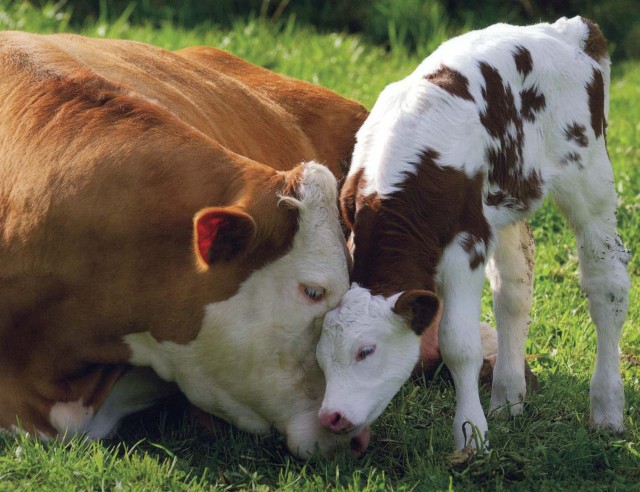If slaughterhouses had glass walls, everyone would be a vegetarian.
~ Sir Paul McCartney
A story was recently published in our local paper, the Daily Pilot, about a visit by a dairy cow to an elementary school. The Mobile Dairy Classroom, sponsored by the Dairy Council of California, makes trips to schools to teach kids about “where their food comes from”. In my work for animal rights and welfare, I’ve seen all too graphically exactly where our food comes from. And it is not as the meat and dairy industries would have us believe. I knew that the kids (and their parents) meeting “Feisty” the cow were not being told the truth, and were deliberately misled in order to ensure their continued support of Agribusiness. Even people who don’t eat meat for ethical reasons may be surprised by the inherent cruelty in the production of dairy products. Dairy cows and their babies suffer tremendously. It is this reality which has led many vegetarians to take the next step toward ethical veganism. The bottom line is that Milk = Meat.
I felt compelled to comment on the article, and submitted my composition to the Daily Pilot, which published it in print and online. Following is the entire unedited commentary as it was submitted to the publisher:
“In ‘A visit from Feisty the cow’, Sept 21, 2012, school children were reportedly given the opportunity to see “where their milk comes from, where all their food comes from”. But the representatives of the Dairy Council who brought Feisty to meet the kids neglected to tell the real story. They purposely hid the truth from the children, because if those kids truly knew where their food comes from, they likely wouldn’t want to eat it. The Dairy Council spends many millions of dollars to mislead the public, portraying “happy cows” gladly offering their secretions for human consumption. But in today’s world of factory farming, the vast majority of dairy products consumers purchase come from animals who are subjected to horrific conditions, then die a violent, painful death. The animals do not offer up their lives willingly for humans’ pleasure.
I’m sure the representative of the Mobile Dairy Classroom did not tell the children that dairy cows spend their lives being kept forcibly pregnant in order to keep their milk production constant, a practice which leads to a number of health maladies, including extremely painful mastitis, among others. Nor did he tell them that when the mother cows give birth, their babies are wrenched away from them soon after, deprived of their own mother’s milk and affection. The separation is agonizing for both, and the crying and bellowing that ensues, often lasting for days, is heartbreaking. The male calves are either chained into crates, their young bodies forced into anemia through a malnourishing diet, to become veal, or slaughtered within days of birth for a cheaper form of veal. The female calves are put into the dairy line to suffer the same fate as their mothers. Cows can live to be 20 years old, but dairy cows usually go to slaughter at only 5 years, their bodies so depleted, they often can’t even walk. Dairy cows’ flesh is turned into cheap hamburger. Like all mammals, cows’ milk is intended for their babies. Human beings are the only species who continue to drink breast milk after infancy. And not only that, it is the milk of another species!
One of the school children remarked about cows, “I think they’re really cool”. Children do tend to relate to animals, and have a natural affinity for them. They’ll tell you that they love animals, and are fascinated by them. But there is an enormous disconnect when it comes to meal time. The same animal they think is “really cool”, is now a slaughtered corpse, which they’ll eat with gusto. Every day, children eat the tortured remains of intelligent, sentient creatures they consider to be their friends. This is because the truth about where their food comes from, and what it really is, is strategically hidden from them in order to sustain the interests of Big Agribusiness. If given the opportunity to learn without prejudice, and employ their own critical thinking, most children would certainly choose to not harm others unnecessarily. And it is unnecessary, in the developed world, to eat animals.
I’m glad to see that organizations such as the Institute For Humane Education are also making trips to schools, presenting children with factual information about the lives of animals, and giving kids the chance to draw their own conclusions about how they want to treat their fellow earthlings, human and otherwise. Humane Education programs, in fact, are now a required part of California’s curriculum. Parents who pride themselves on providing a well-rounded education for their children would be wise to be candid about the reality of food production, rather than employ deception every time their kids eat. Otherwise, they’re doing a disservice to their children, and sending mixed messages about being kind and compassionate citizens.”
I was pleased to see that the paper published my commentary with only some moderate editing, omitting a small portion for the sake of length.
- To see the commentary as it appeared in the Daily Pilot, click here.
- To learn more about the dairy industry, click here (this link is text only, and does not contain photos) and here (contains some mildly graphic photos).
- That’s Why We Don’t Eat Animals, by Ruby Roth, is a highly acclaimed book which teaches kids about animals, contrasting their lives in the wild to the conditions of factory farms. It is candid, but not overly graphic, encouraging children to see all animals as deserving of their own natural lives.


I love your photo. Beautiful!
Thank you for reading and commenting! It’s easy to post beautiful photos with such adorable subjects! I hope you’ll stay tuned for more…
Pingback: Calling All Ethical Vegetarians: Ditch the Dairy | Compassionate Citizen